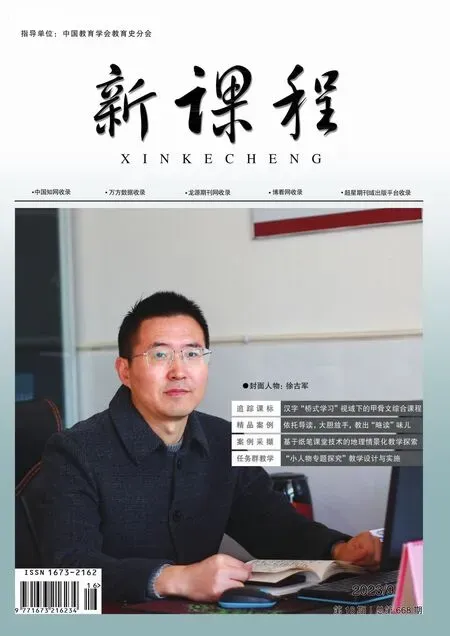英语词汇教学的几点尝试
文|朱贵珍
《义务教育英语课程标准(2022 年版)》对5~6 年级学生的语言能力中感知与积累目标的具体要求是:能领悟基本语调表达的意义;能理解常见词语的意思,理解基本句式和常用时态的表达的意义。所以,学生对词汇的掌握是否准确、熟练,直接影响其句式和时态的表达。因此,课堂中教师结合语境、主题,对重点词汇的训练非常有必要。笔者在多年的小学英语词汇教学的尝试中,略有所得。
一、词不离境,以用促用
达克沃斯说过:“我为学生提供情境,促使他们思考,并观察他们如何做,他们告诉我如何思考,而不是我教他们如何思考。”以译林版6A Unit 3“Holiday fun”教学为例,课中我经常利用chant 复习六年级上册的难点内容——不规则动词的过去式。例如:see—saw,eat—ate,catch—caught,find—found,tell—told,bring—brought,go—went,lose—lost,become—became 等,学生经常会遗忘。如在“Holiday fun”一课中,国庆节假日是本单元的话题内容,让学生在讨论话题过程中感知一般过去时的用法。为了激发学生熟练掌握不规则动词过去式的用法,教师可设计一个头脑风暴活动,可促使学生在轻松的chant 节奏中运用词汇学会一般过去时的句式,实现语言能力的提升。
教师首先利用多媒体向学生展示chant 规则:
T:I say“see”,you say“saw”.
T:see.
S:saw.
T:I say“I often see some trees in the park.”You say“I saw some trees in the park yesterday.”
T:I often see some trees in the park.
S:I saw some trees in the park yesterday.
当学生理解了规则后,便开始放chant 音乐,跟着节奏巩固不规则动词的过去式和相应的一般过去时的句式。等学生完全掌握了这个转换,教师可以撤掉阶梯“I say...You say...”句式,直接说:I usually eat an apple everyday. 让学生直接转换:I ate an apple yesterday.以此达到训练学生转换时态的能力,让学生使用不规则动词构建句子,以提升学生的高阶语言能力。当学生完全胜任这个chant 和这个肯定陈述句的契合练习后,教师可以在以后的课堂中提高难度,延伸到否定陈述句、一般疑问句和特殊疑问句。
否定陈述句,如:
T:I say“don’t”,you say“didn’t”.
T:don’t.
S:didn’t.
T:I say“I don’t bring some drinks to school today.”You say“I didn’t bring any drinks to school yesterday.”
T:I don’t bring some drinks to school today.
S:I didn’t bring any drinks to school yesterday.
一般疑问句,如:
T:I say“Do”,you say“Did”.
T:Do.
S:Did.
T:I say“Do you go to the park every weekend?”You say“Did you do to the park last weekend?T:Do you go to the park every weekend?S:Did you do to the park last weekend?特殊疑问句,如:
T:I say“What do”,you say“What did”.
T:What do.
S:What did.
T:I say“What do you do on Sundays?”You say“What did you do last Sunday?”
T:What do you do on Sundays?
S:What did you do last Sunday?
这样的练习必须建立在以前一个句式非常熟练的基础上,如否定句必须建立在肯定句非常熟练的基础上,才可以逐步开始,特殊疑问句必须是在一般疑问句非常熟练的基础上才可以教授,不可操之过急。在学生没能准确转换之前,教师一定多给阶梯、多给句式,让学生在模仿中体验,当大部分学生习得之后,再撤去阶梯,教师给出一般现在时句式,让学生直接转换成一般过去时句式。
二、结合词法,触类旁通
教师利用已学的词去理解和运用新词,并能遵循构词法自主创新拓展词汇,实现触类旁通的效果,体现学、思、创结合,提升学生融会贯通的能力。
例如,在教学译林版5A Unit 2“A new student”时,文本中的词汇computer room,music room,art room等,就可以利用已学的classroom,living room,bedroom等词进行正向迁移。除了computer 是新词,其他都已学过,学生迁移得很快,教师可鼓励学生根据图片提示创新出新词,如clothes room,piano room,dancing room 等。又如,在教学译林版英语6B 一、二单元的副词时,教师就可以先复习相应的形容词,引入副词的词缀ly,然后引导学生根据happy—happily,sad—sadly,slow—slowly,bad—badly,quiet—quietly 等范例,自主总结出一些规则,然后再给出一些词,如beautiful,careful,clean,messy 等词,让学生自主写出与这些形容词对应的副词。教师要对举一反三的学生以肯定,尤其是对将messy 的y 变为i 再加ly 的学生,表示赞扬。
在教学译林版英语6A unit 2“What a day! ”时,会遇到天气类词汇sunny,cloudy,rainy,windy 等,教师可出示sun—sunny,cloud—cloudy,wind—windy,rain—rainy,让学生自主总结规律,并以图片引入新词snow,fog,ice 等词,鼓励学生根据规则创新出snowy,foggy,icy,对于自己领悟到fog 需要双写尾字母再加y 和ice 要先去掉不发音的字母e 再加y 的学生,给予特别的表扬,肯定他们爱动脑筋、爱思考的品质。除了简单的词汇的教学,教师可以利用正向迁移,引入更有难度的词组,如a parrot show,可以引导学生说出a flower show,a panda show,a car show,an animal show,a fashion show 等,再如译林版6A Unit 5“Signs”时,由课本里的句式No eating or drinking./No littering./No smoking.利用图片创设情境,让学生创新出新句,如No running./No shouting./No playing./No climbing./No talking 等。
结合图片中的内容创设语境,进一步引导学生感悟新词,并让学生结合新词汇进行表达,有效提升学生的语言运用能力。
T:Where did you go for the holiday?
S1:I went to the park.
S2:I went to Sihong Shidi Park.
T:Shidi,we can say it wetland. Wet and land,wetland.(带领学生读wetland)(再呈现Sihong Wetland Park. 引导学生多读几遍)What did you do there?
S1:I had a picnic and played games.
T:What did you do in Sihong Wetland Park?
S2:I saw many interesting animals there.I walked and played there.The wetland’s air is very fresh. I like walking there.
T:How was your holiday?
S1:It was happy and funny.
S2:It was wonderful.
T:The wetland is very beautiful and important.We should love and protect it.
这一环节中,由学生对话引出词汇wetland,并向学生理解wetland 的构词法:wet+land=wetland,既让学生领悟了wetland,明白家乡风景名胜的英语表达,又可以适时激发学生热爱湿地、保护湿地的意识,体现了英语学科教学中“人与自然”的链接和融合。
三、主题探究,灵活创新
《义务教育英语课程标准(2022 年版)》秉承在体验中学习、在实践中运用、在迁移中创新的学习理念,倡导学生围绕真实情境和真实问题,激活已知,参与到指向主题意义探究的学习理解、应用实践和迁移创新等一系列语言学习和运用活动中。如在教学译林版教材6B Unit 7“Protect the Earth”中useful和6A Unit 5“Signs”中的careful 等词时,教师都可以利用曾学过的词汇beautiful,wonderful,激发学生正向迁移到use—useful,care—careful,并引导学生迁移创新出句式:People use water to clean his clothes.Water is useful. 并利用The Magic Brush 的视频创设情境,激发学生触类旁通:Maliang always helped people with his magic brush. So Maliang was _______.引导学生说出helpful. 用孩子们玩耍的图片创设情境,激发学生完成句子:Many children like playing.They are_____.引导学生大胆说出playful。
在学习6A Unit 4“Then and now”时,当学到ebook 时,教师可以创设情境,引导进行如下对话,激发学生学用结合,创造性地使用语言:
T:I liked reading e-books on the computer. But now I only read e-books on my smart phone.(呈现智能手机)I liked sending e-mails to my e-friends on the computer. But now I send my sound message on Wechant. (出示微信的聊天图)Time is changing.Many things are changing. What is changing too?Can you find and tell me?(呈现过去汽油轿车和充电轿车的图片、自行车和电动车的图片)
S1:My father liked driving a car to work before.Now he likes driving an e-car to work. The e-car is green and cheap.
T:Yes. Driving e-cars can protect our air. We should protect our earth and the envionment.
S2:My mother liked riding a bike. But now she likes riding an e-bike. The e-bike is fast and it can carry heavy things easily.
T:Right. I like riding e-bikes to work too. It can save more time than the bike.
这样含有一定主题的对话,让学生可以创新运用语言阐述时代的变化带来的一些生活方式和交通方式的改变,体现“人与社会”的链接,也让学生根据e-mail,e-book,迁移到e-car,e-bike 等词,拓宽了学生的词汇量。
在带领学生学习6A Unit 7“Protect the earth”时,因为整篇都是介绍性的文本,为了避免枯燥乏味,教师可利用图片和视频等创设情境,以“Protect the earth”为主题,和学生进行如下对话:
T:To protect the earth,we should protect our hometown Sihong first. What should we do to protect Sihong?
S1:We should save water and reuse water.
T:Great. We should turn off the tap after you washing your hand.We should reuse washing vegetables and fruit’s water to water flowers and trees. We can reuse the bathing water to mop the floor or flush the toilet.(呈现相关图片,以助学生理解)
S2:We shouldn’t litter.
T:Right. We shouldn’t litter on the street. We should’t litter into the river and the lake. We should keep our hometown clean and tidy.(配上动作和图片,帮助学生理解)
S3:We shouldn’t drive to school.
T:We can walk to school and ride a bike to school.
S4:We should save paper.
T:Yes. We should write on the both sides of the paper.
S5:We shouldn’t pour dirty water from the factory into the river.
T:Wonderful!We shouldn’t pour the dirty water the factory into Bian River,Sui River and Hongze Lake.We should make them clean and clear.(出示泗洪的汴河、濉河和洪泽湖的图片)Many fish,hairy crabs,lobsters and other lives live in the rivers and lakes.(呈现鱼类、螃蟹、龙虾等图片)We should protect them.
教师通过这些主题性很强的对话,让学生明白保护地球要从身边的小事做起,爱护环境、爱护地球,人人有责,也带领学生拓展词汇mop,flush 和泗洪水产大闸蟹hairy crabs 和附近河湖的英语表达Bian River,Sui River,Hongze Lake。这样既增长了学生的知识和生活智慧,也培育了学生热爱家乡、保护生态的意识和能力。
学生学习词汇时需结合语境,并契合相应的主题,才能自主去理解和运用语言表达,灵活地运用词汇进行阅读、写作和交际,并在阅读、写作和交际中获得启迪,增长智慧,形成正确的价值观,学会做人和做事,处理好“人与自我”“人与自然”“人与社会”的关系,成为更好的自己。

